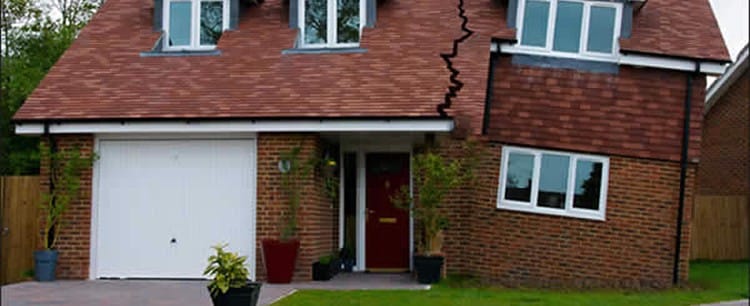GUIDE TO SUBSIDENCE AND SUBSIDENCE INSURANCE
Contents
- Introduction
- What is subsidence?
- What properties are affected?
- Types of subsidence
- Spotting subsidence
- Subsidence insurance
- Summary
Guide to subsidence and subsidence insurance
Introduction
The prospect of subsidence, heave or landslip is probably one of any property owner’s worst nightmares. (Note that subsidence, heave and / or landslip, are three separate types of incident, but usually get wrapped up under the category of subsidence).
The effects of any of these may be devastating, leading to considerable expense in making repairs, effecting remedial works, or completely reconstructing the property.
Subsidence does not respect the value of the building, its type or – in many instances – its location.
Although the effects may be so dramatic, however, subsidence may be the result of many different causes and it is notoriously difficult to spot – especially in the early stages, when timely action is likely to prove the most effective, not to mention cost-effective, treatment.
Thankfully, subsidence insurance may be available for any home, buy to let or commercial property, to help protect you against the financial losses caused by subsidence – and we have made it a particular speciality of our broad product offering.
In our experience, however, subsidence insurance may be one of the least understood elements of property insurance – with a number of our customers asking about subsidence itself, the form it may take, and just what subsidence insurance might cover.
So, we have produced this guide to help steer you through some of the terms, issues and points to consider when arranging your insurance – addressing the following subjects:
- what is subsidence?
- what properties are affected?
- types of subsidence;
- spotting subsidence; and
- subsidence insurance.
Hopefully, it may serve as an informative guide to subsidence and subsidence insurance, but if it leaves any stone unturned or questions that have been unanswered, do not hesitate to contact us – either by telephone or by making a direct online enquiry.
What is subsidence?
The Subsidence Forum explains that:
- subsidence is the downward movement of the site on which a building stands – where the movement is unconnected with the weight of the building. Essentially, the soil beneath the building’s foundations is unstable;
- heave is often listed as part of the same insured peril in domestic insurance policies. Heave is the opposite effect of subsidence, when the site upon which the building stands moves upwards (and often has a sideways element to it);
- landslip is often listed within the same peril in the insurance policy. Landslip is generally dramatic, and needs little explanation.
Subsidence, heave and/ or landslip are all typically lumped together under the term “subsidence”.
As the most common of these three, however, the following description focuses on subsidence. We do cover off descriptions for heave and landslip further on in this guide
Subsidence may occur when the ground which supports the foundations of the building become unsettled, disturbed or collapse or swell. With the foundations compromised in this way, the whole building may be affected by the shift in the ground on which it is built.
That process of disturbance or collapse may be caused by a number of reasons:
Clay-based soil
Subsidence claims are generally linked with the clay belt that sits across the South East of England as clay shrinks and swells depending on its moisture content. However, clay is found elsewhere in the UK too, and 2018’s extended dry spell affected large areas of the North West, North East, South West and the Midlands, producing a 400% increase in subsidence claims for the first time in a generation.
Note: Don’t panic if you live in an area where the hazard is extremely high: experts would expect subsidence in only a small proportion of properties.
Trees and bushes
Trees and bushes which are growing near the walls of the building naturally rely on their growth on the water present in the soil – when that dries out and the roots of trees and bushes spread their roots further into shrinking soil, that again may lead to the onset of subsidence.
A revealed that urban trees are now growing far larger than is desirable, exacerbating the risk of subsidence. This, they say, is due to ten years’ of financial austerity affecting local authority budgets, and the departments that deal with tree maintenance. Most councils have reduced their tree pruning programmes.
The same report from Crawford’s also highlighted how poplars, willows and oaks are among the worst culprits for causing subsidence. This is because they have long root structures that can stretch for over 30 metres and may soak up more than 50,000 litres out of the ground each year.
Defective construction
The same report also says that the depressed housing market means fewer people have moved home, with many instead choosing to extend their current properties. The quality of these extensions – especially their foundations – is variable.
Extensions have also moved the external walls of many properties nearer to large garden trees, and many of these types of development have not yet been exposed to a high-risk subsidence year.
Broken pipes
In addition to the drying out and shrinkage of soil around the foundations, in areas of lighter, sandy or chalk soils, subsidence may also result from the ground becoming swollen with water – this might happen when supply pipes, drains or rainwater goods break and flood the ground with water, effectively washing away the soil supporting the foundations.
Past mining
Mining or other extraction industries which have taken place in the area in the past may have left places in which the ground suddenly gives way, once again leading to the collapse or damage to a building’s foundations.
Technical building studies into the causes of subsidence abound. The Clay Research Group, for instance, has confirmed the correlation between the incidence of subsidence in property built on clay soils – and warns that the problems are likely to be exacerbated if trees and large bushes are growing close to buildings. As the roots of trees and large bushes spread, so more and more moisture from the soil is absorbed, there is steady shrinkage of the ground supporting a building’s foundations and the risk of subsidence increases.
Other studies have shown that subsidence is a global problem. The American USGS Water Science School, for example, also confirms that subsidence is most likely to occur when unusually large amounts of water have either been drained out naturally or allowed to be withdrawn from the ground on which property is built. The soil and its rocks compact, since the water itself plays a part in holding the ground up. When the water is taken away, the ground collapses into itself.
Some locations, therefore, built on particular types of soil may be especially vulnerable to the risk of subsidence – a risk that is likely to be heightened by trees and bushes growing nearby.
So, location is likely to be critical, but what types of property might be affected?
What properties are affected?
Subsidence, heave and / or landslip does not discriminate between buildings of different types. The property may be large or small, it might be expensive or more modest, it might be in residential or commercial use.
This may help to explain the high number of subsidence claims handled by insurance companies in an average year. Academic research has quoted figures produced by the Association of British Insurers (ABI) to suggest that more than 35,000 claims are made in an average year for domestic property alone, with total settlements in the region of £250 million.
Following especially hot and dry summers – especially in regions experiencing drought conditions – these figures escalate to as high as 50,000 claims and pay outs for insurers of up to £400 million.
More alarmingly, perhaps, is the prospect of climate change making more long, hot, dry summers – such as the summer of 2018 where there was a 400% surge in subsidence claims – the weather of the future.
Properties at risk
Rather than the type of property likely to be at risk of subsidence, therefore, is the question of its location.
As already mentioned, higher risk areas may be those where the soils are predominantly clay, sand or chalk or those developments on the site of former mining or other mineral extraction industries.
The difficulty may lie in finding out whether your own property, or one you are planning to buy, is located in any such area. You might consider:
- reviewing what you know of the history of the property and, in particular, whether there have been any indications of a problem with subsidence in the past;
- asking the vendor of any property you are interested in buying whether there has been any such problem;
- the survey you arrange before any purchase may reveal the potential for possible problems – especially if evidence of past remedial works is found; or
- doing your own research into the prevailing conditions in the area by consulting the maps prepared by the British Geological Survey (BGS)– these are based on detailed geological studies of rock types that are prone to shrinkage and/or swelling so that forecasts may be made about the stability of the ground and the evidence of collapsible or compressible ground, unstable slopes prone to landslides, running sand and rocks that may be subject to shrinkage, swelling or dissolution.
The BGS makes available the information on these hazards – all of which may point to the risk of subsidence – to local authorities, companies and to individual members of the public.
The problem remains, however, that subsidence may strike in pretty well any location and may take any number of different forms such as heave or landslip – so, what are the principal types of subsidence?
Types of subsidence
Different authorities may use slightly different terms to describe what is known generically as subsidence, but the various types are generally grouped into the following:
- shrinkage and/or swelling;
- heave;
Shrinkage is a problem most commonly found in clay soils, whose structure naturally contains a relatively high content of moisture. In sustained dry temperatures, the soil dries out, the water table drops, and the clay soil begins to shrink.
Shrinkage tends to occur unevenly, so that a building’s foundations are not only disturbed but also settle in an uneven manner, leading to failure of the walls supported by those foundations.
Shrinkage may be exacerbated by trees and large bushes growing near the building. These absorb water from the ground as they grow, the roots spread and, as more moisture is removed from the soil, so it begins to shrink.
As explained in a paper written by the Clay Research Group (CRG) and OCA UK Ltd, this leads to heated debate between town planners looking for a greener urban environment through the planting of trees and homeowners (and their insurers) who may prefer to tackle the risk by removing trees completely.
In fact, there is an environmental argument for retaining trees and keeping their growth under control. If they are felled or uprooted, a void is made in the ground in which they were growing and this in itself might cause subsidence. By regular and careful pruning and, the reduction of excessive foliage, on the other hand, the spread of damaging roots may be kept at bay and the risk of subsidence reduced.
Swelling of the ground in which foundations have been built may also cause subsidence. Swelling occurs through any rise in the immediate water table or when the ground becomes waterlogged. This has the effect of washing away some of the ground supporting the foundations. It may be caused by flooding in the area or even a burst water supply pipe or fractured drains and blocked soakaways.
Heave
Heave also describes a swelling of the ground surrounding foundations and is typically associated with clay soils expanding when they become wet. The Institution of Civil Engineers (ICE) explains that this waterlogged clay soil cannot usually expand sideways or downwards and instead forces the soil up.
To that extent, heave might be seen as the opposite of the downward settlement of the ground through shrinkage – most commonly associated with subsidence.
Trees and large bushes may again be the culprits, but for the very opposite reasons to those already mentioned. If the trees or bushes have died or they have been felled, their roots are no longer taking up water from the ground. The ground swells, causing an upward heave and the potential for considerable damage to the building.
Landslip
Landslip may be one of the most dramatic types of subsidence. It is the sudden collapse of ground from a higher point to a lower one and is a process constantly occurring through entirely natural causes along Britain’s coastline as the sea and the weather erode and undermine softer soils.
But landslips occur inland, too, and, as the Subsidence Forum declares, the results are obvious and dramatic.
Sinkholes
Just as dramatic as landslips are sinkholes (the technical term is dolines), aptly named for a sudden opening of a potentially large hole in the ground, capable of swallowing a whole building.
may open up when the weight of buildings or other construction presses down on bedrocks which have been eroded. Those most susceptible to such erosion are limestone, carbonate rocks and salt deposits, explains Conserve Energy Future (CEF).
Although sinkholes that appear in the UK may not be as wide or as deep as in some other parts of the world, they are nevertheless increasing in frequency, according to a report in The Week magazine.
Spotting subsidence
Spotting signs of subsidence in your property is important to be done – the earlier the problem is spotted, the sooner and less costly are remedial works able to be done.
The problem is that it is easier said than done, and many of the first signs of subsidence may be very similar to other, less serious, events. If you have any suspicions at all, therefore, professional advice from a qualified surveyor or civil engineer is almost certain to be required.
As some first steps before raising the alarm (with your insurers and the relevant professionals) therefore, look out for any of the following signs suggested by the Royal Institute of Chartered Surveyors (RICS):
- cracks which suddenly appear or have recently expanded in the plasterwork on the walls inside the building – the cracks are typically tapered, spread diagonally across the wall and do not close up of their own accord over time;
- cracks which appear in a similar way on the exterior brickwork or rendering;
- since these typically have their starting point around window and door frames, doors and windows may begin to stick or jam for no apparent reason; and
- wallpaper may begin to ripple for no apparent reason – it is not caused by damp conditions, for example.
It is because these symptoms may have appeared for many other, less serious, reasons that it is important to take professional advice and that is why, as soon as you raise your concerns with your insurers, the first step is likely to involve a formal inspection and survey.
Subsidence insurance
As may have become clear, subsidence, heave or landslip are a serious problem, capable of causing considerable damage to any property, and likely to prove expensive to repair and remedy.
That is why subsidence insurance is an important safeguard – and one of the leading offerings in our own range of products.
Understanding subsidence insurance
Important as it may be, however, the nature and extent of subsidence insurance is often misunderstood and, if your property has suffered subsidence damage in the past, it might be difficult to obtain – insurers, may reject your application for cover, specifically exclude cover for subsidence, increase the premiums you need to pay, and increase the amount of excess payable on any claim (excesses of £1,000 or more are not uncommon).
That is why we have drawn on our expertise and experience to identify those insurers prepared to extend the cover you need – even when your property is in a location known to be vulnerable to subsidence through shrinkage, swelling, heave, landslips or sinkholes or which have experienced such problems in the past.
What it covers
In a detailed briefing note on the subject, the Financial Ombudsman Service offers the reminder that subsidence insurance typically covers the cost of repairs and remedial works following subsidence, but not for any building works which might be undertaken to prevent it from occurring.
Once you inform your insurers of your concerns about a potential problem, the following course of action are typically covered by your subsidence insurance:
- a technical inspection and evaluation of the property, carried out by suitably qualified professionals, generally conducted over a sufficient period of time to detect and analyse further movement in the structure of the building;
- to prevent further damage, the building then needs to be stabilised – although many people leap to the conclusion that the only solution is underpinning the structure, this is by no means the case;
- in some cases, underpinning is not only likely to be an unnecessarily costly and disruptive process, but might also cause further damage;
- alternative building works – such as piling and beaming, pad and beams, piled rafts or grouting may be suitable works;
- once the property has been stabilised in the most effective way, repairs may be carried out to the damaged superstructure – cracks filled, masonry strengthened if necessary, and the property redecorated.
Domestic Subsidence Agreement
The Association of British Insurers (ABI) has devised an agreement between insurers to handle situations in which a homeowner switches insurer, but then discovers subsidence.
In order to determine whether your previous insurer or new insurer needs to handle the claim, the Agreement establishes that your previous insurer deals with any claim you make within 8 weeks of switching insurers, that in any claim made between 8 weeks and one year settlement is made on a 50/50 basis by both insurers, and that if the claim is made after one year, your new insurer deals with it.
Subsidence caused by coal mining
In the specific instance of subsidence caused by coal mining, you may have recourse to government-funded compensation – although the official website suggests that your first course of action is to alert your insurers, who may then contact the Coal Authority to pursue the matter.
Summary
Subsidence is enough to give any property owner a major headache – not to mention serious concerns about the financial cost of putting things right.
The problem is that subsidence comes in many shapes and forms, caused by a number of reasons, and giving rise to potentially misleading or difficult to interpret symptoms.
Because of the potential costs involved in remedying and repairing the damage caused by subsidence, insurers are naturally wary and some may reject your application for such cover or impose a punitive rate of premium.
Here at UKinsuranceNET, however, we have made it our business to secure subsidence insurance for those owners of property in areas known to be at risk from subsidence, heave or landslip or which have suffered from the problem in the past.







